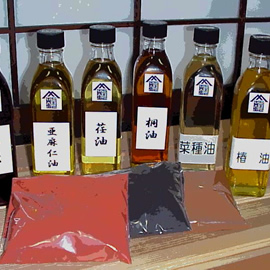Recently, what we call “natural coating” has been drawing plenty of attention, especially since the problem of sick building syndrome escalated.
We offer a variety of natural coating materials and I’d like to briefly focus on those containing materials such as red ocher, persimmon tannin, tung oil and perilla oil, to name a few.
 Ancient wisdom is simply incredible. Our ancestors were well aware of how to extend the life of wood through waterproofing and the applications of insecticides and antiseptics, using nothing but natural coatings, such as natural oil or persimmon tannin.
Ancient wisdom is simply incredible. Our ancestors were well aware of how to extend the life of wood through waterproofing and the applications of insecticides and antiseptics, using nothing but natural coatings, such as natural oil or persimmon tannin.
However, in the meantime, we developed artificial painting materials, which are easy to apply and dry quickly, ultimately giving wood a more aesthetic finish. In the past several decades, we have hardly seen anybody continue to coat wood using natural materials.
As a result, the recently emerged phenomenon known as sick building syndrome has become a problem of huge proportions. The spotlight shines on the problem because it’s detrimental to the health of humans. But what becomes of wood that is painted with artificial coating materials? When
wood is coated in natural materials, it lives longer because it is able to breathe.
Our two-hundred-year-old building is proof of this. The building is still going strong after only being treated with a natural coating.
But what will happen to all the wood that has been suffocated by artificial coating over the years? It worries us to think that the number of houses built with such wood will likely only increase.
Recently, we have been receiving near-daily inquiries about oil for us on architectural wood from all over Japan. They gradually started to increase over the last two or three years in conjunction with the rise of the aforementioned sick building syndrome.

